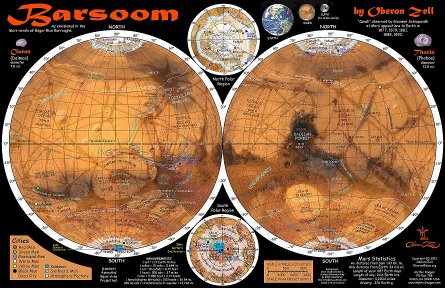Edgar Rice Burroughs’s (ERB) Martian (Barsoom)
novels, although they take place in “the present”, describe current-day
(circa 1866 to 1941) Barsoom as being preceded by a long march of history
going back one million years to a vanished maritime civilization consisting
of white (the “Orovars”), black (the “First Born,” at least in “modern”
times), and yellow (we’ll call them the “Okar” or “Okarians” etc., also
at least in modern times) peoples. ERB frequently tells us that ancient
Barsoom flourished one million years ago. This ancient civilization ended
as the atmosphere thinned and the oceans evaporated, to be replaced by
the rise of the red Barsoomian civilizations and people. All that is left
of this vanished civilization are dead cities and legends, plus a few anomalous
hidden remnants touched upon in some of ERB’s novels1
and fan fiction.
Although ERB never wrote stories that took place within
this past history, there have been a few fan-written stories published
on the Web2
that do so, apparently at the implicit height of the ancient Barsoomian
period. It is intriguing to consider the stories yet untold from these
ancient times, to include those from the never-documented long fall of
ancient Barsoomian civilization. Did these people understand what was happening
as the oceans receded and the atmosphere thinned? What did they try to
do to stop or slow the death of their civilization, beyond building the
canals and atmosphere factory, and ERB’s occasional reference to newer
portions of their cities being built to follow the receding waters? Did
they go quietly with dignity into oblivion, did they approach it with mindless
terror, or did they fight the fall vigorously with intellect and muscle?
We'll try to fill in some of the gaps in this history as we trace the deterioration
of ancient Barsoom, based on our ideas but also building upon the ideas
of others (conveniently found within ERBzine3).
We'll also have some fun doing this!
Weird Science
ERB’s Martian novels contain a good degree of science
not founded in currently accepted fact. We can agree that ERB did the best
he could with the knowledge of his time, and was focused more on telling
a good story than scientific accuracy. Some of the questionable items he
includes are:
-
Life as we know it on a habitable Mars!
-
Egg-laying humans
-
The 8th and 9th rays for aircraft buoyancy and atmosphere
production, respectively
-
“Radium” as the component of proximity-detecting guidance
systems, explosive projectiles and lighting
-
An astonishing range of four and more than four-limbed body
plans
-
Climates and ecosystems that simply don’t match up with our
current knowledge of Mars
-
Storage of the sun’s rays for various purposes
-
A general timeline for civilization that goes back a million
years or so
He also ignores some of the usual vagaries of life:
With one exception4,
no mention of weather and season other than his mention of hot days and
cold nights.
Not much is said regarding disease.
We shouldn’t let facts spoil having fun with the Barsoom
he created, nor should these facts bar us from creating new stories. In
fact they can help us make the telling that much more interesting. We may
also indulge in a little weird science ourselves in the process of doing
so. It’s also interesting to note where his stories align fairly closely
with reality – his descriptions of geography, for instance, have been aligned
with modern astronomical observations5. We’ll
leverage some of these alignment observations below. For example, it’s
been proposed that the Northern Hemisphere of ancient Barsoom was largely
covered with ocean, due to its lower overall elevation, with most of the
habitable land in the Southern Hemisphere. We also have another area to
address regarding science. From today’s viewpoint (but not necessarily
ERB’s) the ancient Barsoomians were civilized for many thousands, possibly
tens or even hundreds of thousands years. Why didn’t they develop a technological
civilization and simply migrate to Jasoom (Earth)? To our Western civilization/"Jasoomian"
view they must certainly have had sufficient time to do this, since after
all, we went from the first powered flight to the Moon in 66 years. There
certainly were other authors writing about space flight who were contemporary
to ERB6.
Did it simply not occur to them, or was limited space-flight achieved and
then lost or suppressed?
What Caused Barsoom's
Oceans and Atmosphere to Deteriorate?
Let's talk about the Barsoomian atmosphere and oceans.
We’ll start with some basic physics. Retention of a stable
atmosphere by a planet is a function of a delicate balance of temperature
and gravity. Pressure, at the thermodynamic level, is a function of the
motion of individual molecules of atmospheric components, which increases
when you heat these molecules. Gravity pulls on the molecules and keeps
them from caroming off into space. Some do7,
but as long as their energy is below a certain level, and the gravity above
a certain level, a stable atmosphere can be retained. If the concept is
unfamiliar think of lots of rubber balls bouncing around in a room – they
occasionally hit each other. Now if there is an open window occasionally
a ball will escape. Increase the energy of the bouncing and the statistical
likelihood of more balls escaping goes up.
We can assume that this balance was much more delicate
for ancient Barsoom than for our Earth. In fact, let's assume that a slow
loss of atmosphere and water was already occurring, but at a slow enough
rate that changes were only noticeable over a geological time scale. Remember
this point...
Let’s talk about “greenhouse gases.” Greenhouse gases,
primarily carbon dioxide (CO2), cause greater retention of the Sun's heat,
which over time will cause subtle increases in global temperature if these
gases were to increase in the atmosphere. Plants metabolize CO2 back to
oxygen (O2) – this is part of what ecologists call the “carbon cycle.”
Let’s also assume that the volcanoes of the Tharsis Montes
region were periodically active in ancient “historical” times (Weird Science
Alert! The latest scientific thinking is that they were actually last active
40 million years ago). CO2 is a major product of volcanism. (There would
probably be much said about these volcanoes in this religion too – there’s
a story in there.)
We can assume that the early peoples of Barsoom probably,
as they evolved from primitive hunter-gatherers to agriculturists, began
to burn off forests to obtain more croplands. Fire also generates CO2.
This burning would both increase the amount of CO2 and reduce the amount
of plants able to metabolize CO2 back to O2.
So, the situation we have is that, as population rose
with increasing civilization there was an ever-increasing need for more
cropland, which necessitated increasing burn-off of the forests. We have
the atmosphere of ancient Barsoom getting loaded up with greenhouse gases
while the ability to remove these gases is being decreased. Thus, ever
so slowly, Barsoom began to warm up. Not by much, mind you, just a few
fractions of a degree. However, that's all it takes for changes to start
to occur.
Thus, the ancient Barsoomians sealed their fate. Forest
burn-off upset the balance. The increase in CO2 caused more heat to be
retained by the atmosphere, and more atmosphere would begin to escape into
space. At the same time, O2 production from vegetation goes down. The atmosphere
begins to thin. This thinning would be disproportionate to the composition
of the atmosphere – the lighter molecules (O2 and nitrogen) would go before
the heavier molecules (CO2).
So what about the oceans? The Barsoomian temperature elevation
would impact them also, causing some subtle changes here too. Similar to
the atmosphere, liquid water actually exists in an equilibrium with its
other physical states, so there are always some water molecules existing
in the gaseous phase present. We commonly call the transition of liquid
to gaseous water that occurs at temperatures comfortable to us "evaporation"
-- this increases with increasing temperature until we reach a point where
we are boiling the water, and the equilibrium significantly favors the
gaseous state (to the chemists in the audience – we know we’re simplifying
this a bit). Where this gets really interesting is at higher altitudes
(lower air pressure). Try boiling water at higher altitudes and you'll
find that it boils at a lower temperature -- some things like hard-boiled
eggs are much harder to cook because that transition of liquid to gas is
occurring at a faster rate at lower temperatures. At a low enough pressure
water can actually go from ice to a gas – sublimation. Therefore, similar
to the atmosphere there is also equilibrium here, although it's more affected
by temperature and pressure than gravity, although once gaseous these water
molecules would then be subject to the same behavior as other atmosphere
components. So, after a while, water would begin to evaporate and slowly
escape into space.
Is evaporation enough to account for the loss of the oceans?
Probably not – there were likely some other factors at play here. For example,
we believe today that there is considerable subterranean ice on Mars –
undoubtedly some fraction of the ancient oceans might have ended up in
this form.
The ancient Barsoomians, in an attempt to forestall their
fate, may have actually accelerated their doom. Would knowledge of the
worsening conditions have triggered a religious or intellectual revolution
that attempted to explain or understand the collapse? Could they have experimented
with electrolysis to produce oxygen from water? Might a form of alchemy
have arisen (Weird Science Alert!), focused on binding water and air into
preservable and stable forms or even creating more? Likely “yes,” since
we know that at some point the ancient Barsoomians built the atmosphere
factories. What false starts and mistakes might have been made along the
way that actually accelerated the collapse? Is the scarlet and ochre vegetation
a result of this? Did arcane chemistry result in the runaway binding of
oxygen with iron to form ferric oxides (and analogous compounds with other
atmospheric components?) Is water preserved as subsurface hydrates or in
some arcane chemical form? We’ll assume some of this happened, even if
we again cross over into weird science.
So we have a plausible “smoking gun” for the Barsoomian
environmental and ecological collapse. Increased CO2 caused global warming,
raising the temperature of the atmosphere to a point where the equilibrium
that kept it stable was broken. O2 partial pressure went down at an accelerated
pace relative to heavier components such as CO2. Somewhere in this first
phase the more delicate ecologies would have been disrupted – sessile marine
forms like corals, for example, would have begun to die off early. Food
chains would begin to be disrupted. As atmosphere loss accelerated at some
point so did evaporation through natural and man-made processes, with the
result of the oceans receding and ultimately disappearing.
Timeline
We’ll describe a proposed Barsoomian history using milestones
along a somewhat arguable timeline to the present, leveraging the science
and pseudo-science described above. Where we can, we’ll try to propose
a few explanations of how we got to “present-day Barsoom,” and illustrate
the changes with a few maps.
1. 1-4 Billion years ago
We can begin with the emergence of life on Barsoom. Early
Barsoom (and the other early planets) was subject to massive meteor strikes
(called the “Late Heavy Bombardment”) and tectonic activity. These meteor
strikes created the great rift valleys or other relatively isolated zones,
which could have served as isolated “test tubes”for the evolution of life
in different patterns during an era of a much warmer, wetter climate.
Two or more lines of evolutionary patterns (parallel body
plans) developed in isolation: the four limbed (e.g. humans) and the more
than four-limbed (e.g. green men, thoats, calots)8,
9.
We can suggest that the multiplicity of limbs (up to 10!) was either size-driven
or were the more “primitive” forms, and that many other forms were mutations
from that pattern. We can also assume that combinations of egg-laying and
live-bearing body plans were also present and mixed in here somehow10.
Over time, these isolated zones eroded sufficiently that
life emerged from them, spread out, and re-colonized and competed with
each other. Also over time, Barsoom began to dry; geological activity lessened.
The atmosphere began to thin and protect less from solar and other forms
of radiation; thus more mutations occurred which increased the rate of
evolution.
Much time passed…
2. Millions of years ago
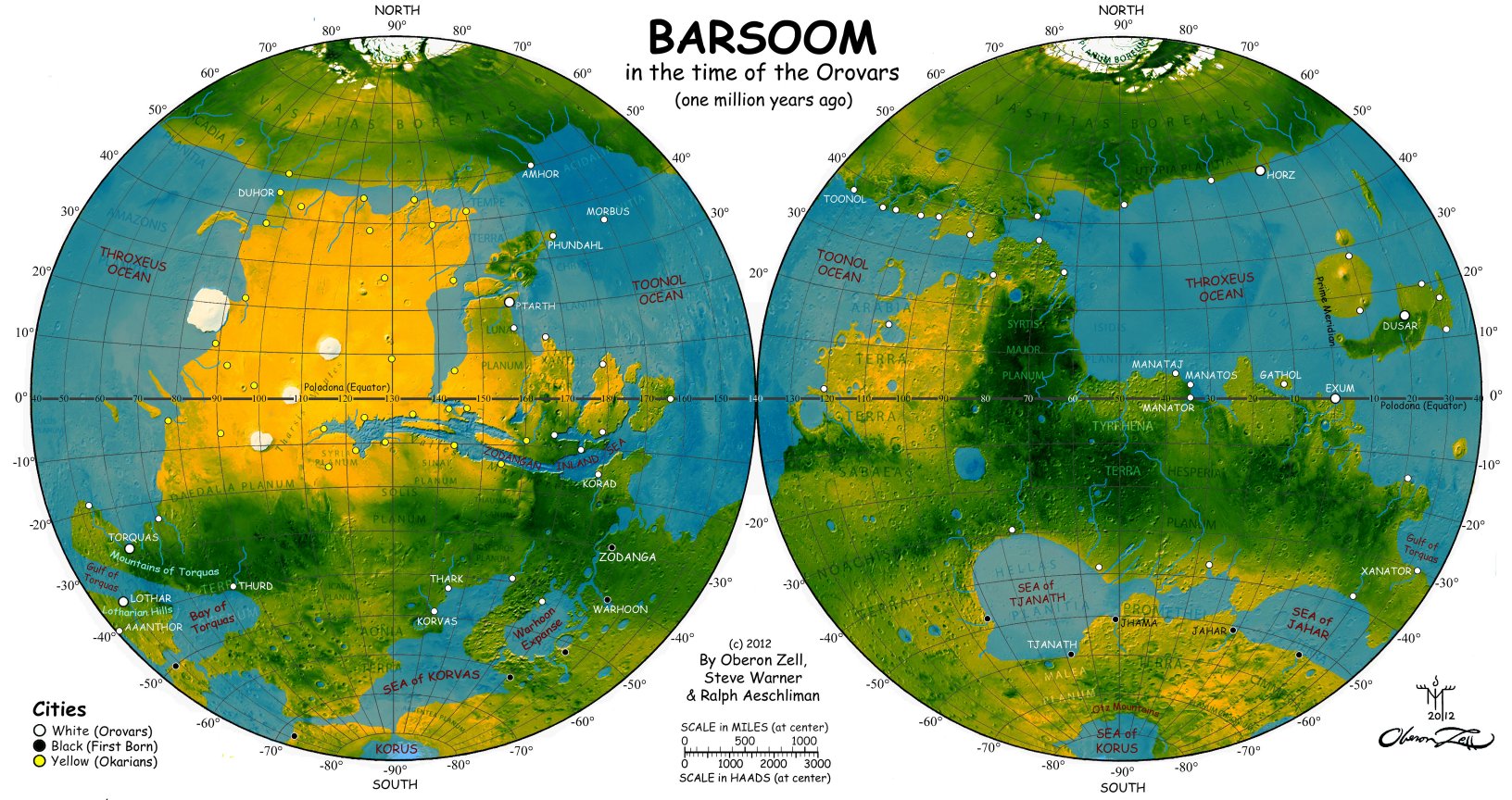
We can envision here a lush world whose ecosystems are
complex and teeming with a wide variety of life on the land, in the air,
and in the seas. The world is still moist although continuing to dry slowly,
and slow drying continues to drive evolution and land-borne migration.
The volcanic highlands of the Tharsis Montes region were still active,
and few men chose to live in this desolate place.True men evolved from
a non-intelligent four-limbed ancestor -- presumably a primate of some
sort. These true men may have been live-bearing instead of egg-laying.
The primitive green men evolved through a path of convergent evolution
from a non-intelligent egg-laying six-limbed ancestor. The kaldanes evolved
far inland, possibly from a crustacean-like progenitor, and were segregated.
Over time, wandering tribes of hunter-gatherers evolved to agricultural
settlements to city-states to nations as slow drying and atmosphere loss
continued to occur. Some history of this time was lost due to incessant
war between wanderers, green men, and primitive villages. Many settlements
reverted back to wandering as they were destroyed and their populations
integrated back into wandering society or were enslaved by green men. Agriculture
became more critical to survival, and, where necessary, there were burn-offs
of forest land to yield more space for crops and also to drive back the
hostile life of the forests (e.g., siths). Slowly the settlements got larger,
wanderers got fewer, sophistication for agriculture and mariculture increased
(and it needed to), and populations increased, with city-states forming
based on trade and mutual defense relationships between their component
settlements, villages, and towns. Some competition and war between city-states
for land occurred, but also cooperation between them against the green
men.The less numerous green men were always in the background as a destabilizing
force and a driver to the true men evolving to a more organized culture.
Indeed, the green men predation on the true men forced isolation of early
men that caused the differentiation into races and the initiation of civilization.
We can plausibly imagine that each race was molded by this isolation in
different ways:
The black race evolved from men driven into the hotter southern
desert regions around inland seas and moisture traps. They early on evolved
a strong martial tradition and cunning to enable them to meet the green
men on an equal footing – mobbing individual green men along with a vicious
campaign of egg hunting and destruction. This combined with protected safeholds
in valleys served to provide the black race with sufficient protection
to begin to civilize.
The yellow race evolved from men driven into the hostile
and often snow-covered mountainous regions around the Tharsis Montes. The
yellow race used simple isolation to reduce the menace of the green men.
With the yellow race living on the inaccessible mountains, the green men
had little incentive to seek them out in this inhospitable environment,
and were readily dealt with in the border regions again by the strategy
of mob attacks.
The white race evolved from men congregated around the rivers
and shores, and were driven early to develop water travel that proved to
be an enabler of civilization in addition to being a strategy for survival.
Spreading across the offshore islands proved to be the ultimate protection
from the green men, who could not follow and lacked the ability to cooperate
among themselves to build sufficient culture to develop a shipbuilding
capability. Population explosion on near-shore islands forced a similar
explosion in ship-building and ocean travel. Others remained on the shores
of the oceans and rivers and maintained contact with their sea-faring brothers.
As urbanization increased so did trade. Early development
of the bow leveled the playing field with the larger and stronger green
men. The bow, combined with stone axes and knives, were the primitive weapons
of choice. Stone Age weapons eventually began to give way to copper, bronze,
iron, and then steel swords, likely short swords in this ancient era. The
bow, evolving from stone to bronze to iron tipped arrows, was the weapon
of choice. Spears may also have been used.
Population moved inland, mostly in the Southern Hemisphere,
as slow drying continued. The discovery of irrigation allowed cultivation
within marginal areas in the southern deserts. The need for better forms
of irrigation prompted the building of small canals and aqueducts, thus
permitting the southern plains to become the "bread-basket" of ancient
Barsoom. Within this environment of plenty city-states and early nations
would form.
Joint expeditions against the green men were another impetus
for nation-forming. Standing armies were formed and campaigns executed
with the purpose of fighting and exterminating the green men. The green
men were never numerous because of their violent nature among themselves
and because they had not yet developed social behaviors or organization
for protecting their vulnerable eggs during the five year incubation period.
Their eggs were thus susceptible to animal predation and destruction by
men (and other green men). Much hatred toward the green men existed amongst
the true men – possibly a racial memory from pre-history – and expeditions
formed against the green men – the green men would retain a racial memory
of this hatred, and return it in kind. Green men were eventually reduced
in numbers and sometimes enslaved or even trained as soldiers (to include
teaching them language), or pushed into the wild lands such as the southern
deserts and other marginal areas. These expeditions would have even become
stylish amongst certain social classes as the expeditions turned from war
more into hunts as the numbers of green men were reduced. At some point
the green survivors would start to cooperate, emulate the true men, and
develop some organization of their own as a necessity to survive against
the constant attacks of the true men. Some green men might even have joined
with the true men.
3. 1 Million years ago
Here we provide our first map, updated
from prior publications (“A
New Map of Barsoom”). At this point the peak of Orovar civilization
was attained11. Much maritime commerce and
travel occurred, and this was the primary means for the spread of civilization,
news, new ideas, etc. We have the First Born centered in the Southern Hemisphere,
the Okar in the Northern Hemisphere around the Tharsis Montes region, and
the Orovars on the shores of Barsoom’s oceans. Standing armies were eroded
or were reduced in size (war was bad for business), and a middle-class
began to arise. We might imagine mercantile nations with philosopher merchants
living in luxury in their cities while the bowman/sailors/hunters evolved
from the armies when there was no longer much fighting. Within the cities
life was good, while the sailors and hunters met enough perils (e.g., piracy,
the few remaining green men) that their population and more violent tendencies
were also kept in check. Although it is tempting to compare this era of
Barsoom to Rome a comparison to pre-1900 India is probably more accurate.
The evolution of civilization resulted in a population
increase that required a proportionate increase in agriculture. This resulted
in an increasing demand for crop land, and thus an increase in forest burn-off
to create new crop lands. At some point a “tipping point” was reached,
and atmosphere loss accelerated.
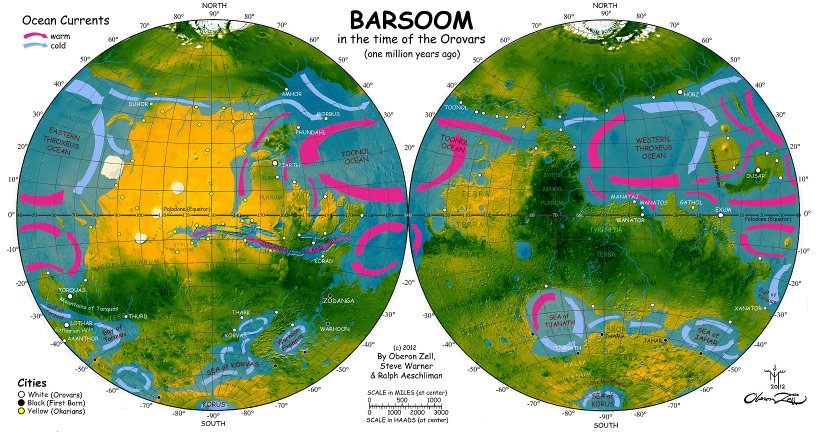
.
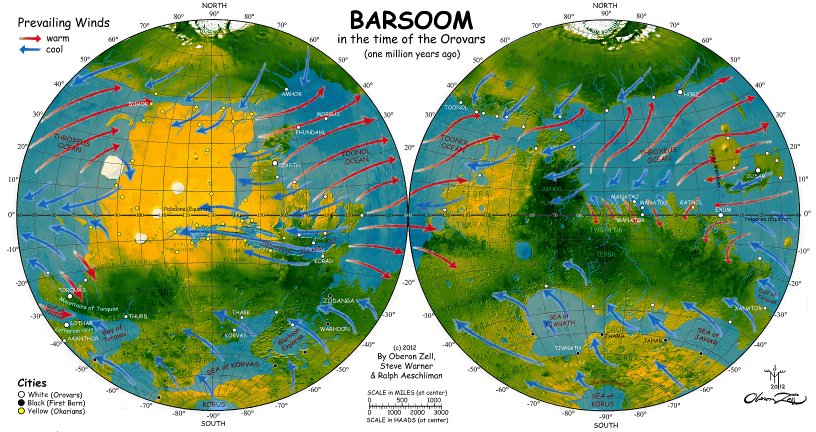
We can also extend our knowledge of ocean current and
wind behavior on Earth to Barsoom, and postulate patterns that would have
driven trade routes and population migrations. These maps should serve
nicely to aid authors in developing stories of this era. Note the location
of Exum at the confluence of both Northern and Southern hemisphere ocean
currents, and the equivalent wind patterns. It’s obvious that Exum would
be a major trading port in the maritime commerce of ancient Barsoom, as
all (sea) roads led to it.
4. 900,000 years ago
At this point we can invoke the acceleration of global
warming (already aggravated by the burning of forests to create crop lands).
Remember that subtle balance of temperature and gravity that impacts atmosphere
retention? With a slight increase of temperature we now have a slightly
more energetic atmosphere -- molecules of atmosphere components will begin
to move faster, and that slow loss of air to space will accelerate. The
situation begins to subtly worsen.
There's been some speculation in the ERBzine about
the climatological "tipping point” that may have accelerated atmospheric
thinning and the drying of the oceans. We propose that this tipping point
was increased activity of the hitherto relatively dormant Tharsis Montes
volcanoes. Volcanoes can eject gases such as CO2 and also solid material
that may be retained for long periods in the atmosphere. In this case,
let's assume that just CO2 and other gases are being released at an accelerated
rate. The result would bean even more elevated rate of greenhouse gases
in the atmosphere, an increased rate of heating, and thus an increased
rate of atmosphere loss.
This would at first be evidenced in any inhabited highlands,
such as the Tharsis Montes region that we propose as the ancestral home
of the Okar. We can imagine a culture with many similarities to the ancient
Incas of South America, with cities at higher elevations. Some of the highest
habitations would experience harsher weather and eventually even difficulty
breathing. Agriculture would become increasingly difficult. The population
of these extreme environments would begin to migrate to lower altitudes.
Islands such as Gathol that were the above water portions
of sea floor mountains would see evidence of ocean drying first as quays
began to appear to rise above the ships they serviced. Ocean shallows would
have begun to become exposed. Droughts would occur in formerly fertile
regions. Crops would fail, forests would begin to die, and formerly fertile
savannahs would become deserts.
It would have become difficult at this point to deny the
inevitable. There would have been a dawning realization of this tipping
point having occurred, and that ultimately it would mean their descendants’
death. Some would have approached this with apathy, some with religion,
most ignored it, others, over time, might have begun to call out for something
to be done to preserve life and civilization, and been pushed into an intellectual
revolution.
With the drying of the forests, wood began to become a
premium trade item – restricting and ultimately ending ship-building and
causing a shift from predominantly wooden weapons (e.g. bows, spears) to
all metal weapons. The long sword became the companion to the short sword
that had been used for ages in close-in fighting when enemies were within
the radius a spear could be used or a bow could be drawn and fired. This
change in weapons would make exterminating the green men that much harder,
even when used by mounted cavalry to address the difference in height (the
green men would eventually copy this to compensate).
At the time of realization that the tipping point was
here technology was mostly at a Roman level with some exceptions (what
ERB knew and his thoughts on where technology might advance). Medicine
was very advanced. There were mostly cottage industries – NO industrialization
whatsoever (no Barsoomian ever figured out mass production, gunpowder or
the steam engine). “Radium” was mostly a curiosity at this point, but useful
for lighting. There were no firearms, but catapults and ballistae could
have been well understood.
We can assume that a minority of various voices for action
would band together and begin working on solutions. Therefore, a great
convocation to discuss ways to address the problem would be reasonable.
Learned savants from all over Barsoom would have traveled to it. This convocation
probably extended over a period of months or years. It was probably quite
lively at times until a consensus began to be reached, or at least enough
of one for action to begin to be taken.
Let’s have some fun with this – there could be some good
stories here! Several decisions and directions likely arose from convocation:
A decision to increase the pace of science and engineering
as any solution would derive from these disciplines
An investigation into the applied use of the 8th ray,
which was otherwise a curiosity. Realization of the possibility of flight,
although there was a containment problem for the 8th ray that would have
led to further metallurgy. Some limited success with small balloons.
Applied use of the 9th ray, also otherwise a curiosity,
with realization that the 9th ray actually could be used for atmosphere
creation
Parallel investigation of other means for atmosphere
creation, such as electrolysis of water to produce oxygen
Some dabbling with space travel but not considered
a solution for the large scale. Gems that produced rays had to be devoted
to 9th ray production
An investigation into protected habitat (“safehold”)
creation such as through extension of the city pits or the sealing of underground
caverns and lava tubes
Hydroelectric power might have been discovered, and
used sparingly
Flight might also have been discovered, but was probably
uncommon and might have been restricted for military and inter-government
communications
Research to better understand ocean evaporation and
air loss. How far would the atmosphere and water loss go? At what
point could it be stopped? Could it be reversed? Could polar water be used?
An investigation into changing the peoples and animals
of Barsoom. Could changes be made so that they could survive with less
air and water? Could better strategies be developed and followed-through
if people could live longer, and focus a longer adult life span to solving
problems?
The black and yellow races, fewer in numbers than the Orovars,
might have then begun to specialize in certain areas of technology:
The black race began to specialize in bio-engineering
(Weird Science Alert!). They realized that life would get tougher and that
the current short lifespan and live birth would not be optimum in a tough
environment. They also realized that the relatively short life span limited
the effectiveness of the individual in defining and making the changes
necessary for survival. Research into life extension and conversion to
egg-laying began. Eggs would better protect the growing child from a harsh
environment, eliminate the vulnerability of the mother during pregnancy,
and allow storage and selective birth. They introduced these changes into
themselves first, and thus are the "First Born" of the Barsoomian races
from eggs, lending some truth to their name for themselves.
The yellow race began to specialize in the physical
sciences, and also exploring the arctic regions in secret. They created
plastics and refined the uses of radium into a science. They secretly established
some small domed settlements in the arctic, and also developed the radium
lighting found in some dead cities.
There could have been a brief further flowering of civilization
due to accelerated technological progress. All of these lines of investigation
and action evolved and converged into “The Great Plan” for survival. The
short term plan was to move12 into rift valleys,
craters, caverns, lava tubes, expanded city pits, polar settlements, the
underground sea of Omean (created from an existing water-filled cavern)
– all moisture traps. Either depth or physical seals would retain air to
some degree. Electrolysis of water to produce oxygen was part of the solution,
done with the knowledge that on an industrial scale it would accelerate
the disappearance of the oceans. The longer term plan was to build an atmosphere
plant (which would not only provide breathable air but adjust its composition
to ensure a proper balance of greenhouse and non-greenhouse gases) and
canals; however these would not be ready in time to prevent significant
ecological collapse.
There was much debate on city pits vs. rift valleys and
caverns as safeholds. The pits would be better at retaining air because
they could be more easily sealed, but where food would come from was unclear.
The mentalists13
sought to create food via the power of thought alone. Experiments with
using radium lights for growing crops were successful but of insufficient
scale to support a large population indefinitely. The pits were thus viewed
as a shorter term solution – they also had small scale air pumps (air compression
– the air was there just not enough). Experiments with solar and gravity
power for the pumps were also conducted.
Biological engineering would have accelerated, with many
successes. More practical genetic engineering means were found to extend
life to about 1000 years, and to also reduce the need for water and transition
to human egg-laying. Other animal forms were also similarly engineered
for egg-laying. Eggs also began to be stored. The story of the Tree of
Life derives from legends of this time. Other forms, such as the dead sea
bottom moss, would also have been developed.
Although these changes were introduced into the white,
black, and yellow races this was viewed as only a partial solution. The
optimum solution was to engineer the red race from all three existing races
– an even tougher and better tailored human for the new environment that
was coming (hybrids already existed). Other plant and animal species were
also similarly toughened with the goal of creating a new ecology suited
to the tough environmental conditions coming, or to at least meet this
change "in the middle."
This accelerated industrialization was a resource drain,
and caused further reduction in available resources (and possibly further
climate change). Martial law might have been declared if panic ensued.
Constraints on travel arose as ships were commandeered for project support,
or were lost and could not be replaced due to the shortage of wood. Some
pirate attacks on ships and cities might occur as resources began to be
scarce. Withdrawal to larger cities to pool resources might have occurred,
with abandoning of smaller settlements. Green men extermination expeditions
would have ended. We would see the beginning of reduction of birth rate.
5. 750,000 years ago.
Barsoom is now a very different place due to accelerating
climatological change from both natural and man-made processes. The Okar
and particularly the First Born begin to become isolated from each other
and the other races. Commerce and civilization in the Southern hemisphere
essentially ends except where the rising populations of the red men permit
them to move into cities abandoned by the other races where resource availability,
geography, and the availability of safeholds permit. The deeper oceans
of the Northern hemisphere, although much reduced, allow civilization to
persist there a bit longer. Caravans begin to replace maritime commerce,
but cannot sustain the volume of shipping and become a target for marauders
and the increasing hordes of green men.
The birth rate continues to plummet, which further accelerates
the abandonment of cities. We begin to see some adaptation to lower air
pressure. The cities that remain populated experience significant breakdowns
of society and social services. The technological and industrial base developed
150,000 years prior is eroding, although the scattered safeholds retain
some of it.
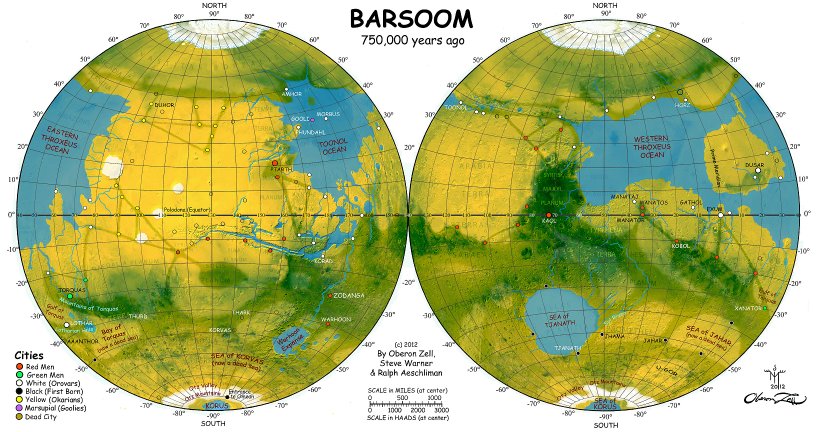
Life has gotten ugly. The Southern plains became uninhabitable
except for green men and the safeholds of the First Born. Life is better
in the North, and Orovar civilization is still very much in evidence.The
short term survival plans are in place, with migration to new niches and
safeholds. There is a rise of warlords who take over some of the safeholds
– some are benevolent and some not. Some wars and riots for safeholds occur
as there is still more population than could fit in them – some safeholds
are destroyed as result, or seized by the green men who enslave their occupants.
Suspicion of strangers begins as they could be advance scouts for raiding
parties. This also results in the rise of the warrior, with universal arming
of the populace and the beginnings of a far more martial culture. Extreme
protection of females begins. Some cannibalism occurs in areas of complete
ecological collapse. There is much storing of eggs in the safeholds.
Despite all this we have the beginnings of the great canal
systems, begun largely by Okarian engineers who build safeholds within
the extensive network of old lava tubes within the Tharsis Montes.
These early canals, along with some rivers and other water courses that
might have been artificially connected and deepened, were the beginnings
of the vast canal network. These canals would allow repopulation
of some areas that had been abandoned.
5. 500,000 years ago
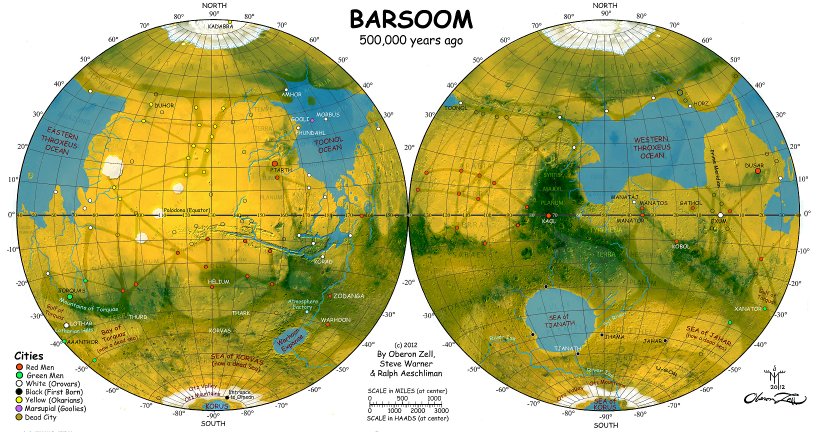
Civilization and maritime commerce is gone – the classical
civilizations have effectively ended and been replaced by a network of
safeholds that follow the expanding network of canals. The oceans are mostly
gone as a medium for transportation (ships had to moor too far from most
cities) except in the far North. Ecological collapse accelerates. There
is loss of some of the more marginal safeholds due to failure of life support
or to disease. Any remaining enclaves of non-egg-layers die out, with discontinuities
in family lines. Remaining enclaves of First Born or Okar not at their
polar safeholds begin to die-out or interbreed early on. There is complete
loss of communications between the races. The atmosphere plant, designed
by the Okar but built by the Orovars and finished by the red men is partially
operational but not before additional population loss occurs. Life is now
limited to the safeholds and moisture traps.
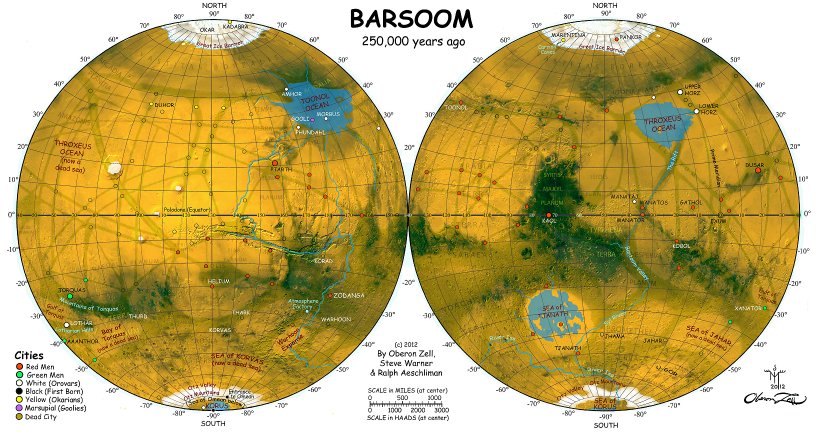
6. 250,000 to 100,000
years ago.
The oceans are gone for all practical purposes.Canal
building continues as the dried out Northern seabeds permitted land access
to the polar ice and the north polar continent. The atmosphere plant is
now fully operational which stabilizes the drying and atmosphere loss –
a new equilibrium of atmosphere and water retention is reached. Population
begins to slowly increase again, but civilization is still a remembered
dream. Many leave the more isolated safeholds, which by now are almost
entirely populated by red men – the Orovars are mostly gone as a pure-bred
race with the exception of a few northern enclaves. The Okar have mostly
retreated to their domed North Polar cities while the First Born have retreated
to the Valleys Dor and Kamtol. Some abandoned cities are repopulated, and
some new cities are built in especially hospitable areas. Green men take
over some deserted cities.
7. Today.
We now see “modern” Barsoom. The red men dominate, with
the Okar and the First Born restricted to their polar refuges.
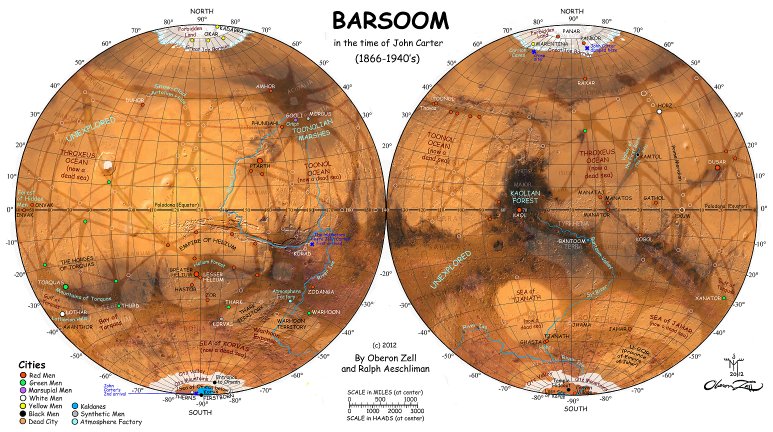
REFERENCES
1 Lothar in Thuvia,
Maid of Mars; The Citadel of Horz in Llana
of Gathol
2 Cf. Pirates at Xanator, Voyage to Zodanga
3 Many excellent works are available on ERBzine
by such as Den Valdron
and Rick Johnson.
4 Chessmen
of Mars
5 Cf. A
New Map Of Barsoom, Geographers Of Mars I: Matching Mars And Barsoom,
Mapping Barsoom II, Mapping Barsoom II, Mapping Barsoom III
6 Cf. Master of Adventure: The Worlds of Edgar Rice
Burroughs, by Richard
A. Lupoff. However, we must remember that science fiction is often
based on the author's world view, and what ERB writes is plausible in that
light.
7 In other words, exceeding the escape velocity of
the planet in question.
8 Evolution on Barsoom
9 I’m intentionally ignoring the three—legged ulsios
of John Carter and the
Giant of Mars.
10 ERB never tells us how thoats, calots, etc. breed.
Are they egg-layers?
11 They certainly co-existed with the black and yellow
races. What was the nature of their interactions? There might be a story
or two here also. Were the red hybrids already emerging?
12 Akin to "generation ships" from other sci-fi genres
13 See Thuvia
Maid of Mars
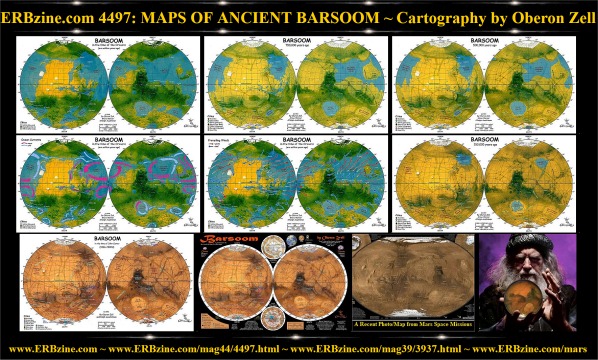
Click for full-size promo collage poster









